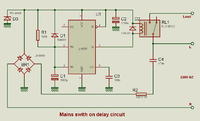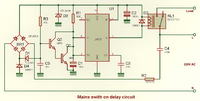Ghost69
Newbie level 4

- Joined
- Jun 25, 2013
- Messages
- 7
- Helped
- 0
- Reputation
- 0
- Reaction score
- 0
- Trophy points
- 1
- Activity points
- 50
i am trying to make a delay circuit which gives a delay of 4 minutes,during which the
supply is disconnected from the output.The delay must start once power is cut off from the circuit,and even if power is back before 4 minutes the power must be cut off from the output till the 4 minutes are over.all the components must be powered by the input source.please do help..
supply is disconnected from the output.The delay must start once power is cut off from the circuit,and even if power is back before 4 minutes the power must be cut off from the output till the 4 minutes are over.all the components must be powered by the input source.please do help..










